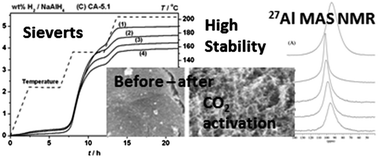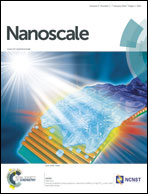Abstract
Nanoconfinement is a promising technique to improve the properties of nanomaterials such as the kinetics for hydrogen release and uptake and the stability during cycling. Here we present a systematic study of nanoconfined NaAlH4 in nanoporous scaffolds with increasing surface area and pore volume and almost constant pore sizes in the range of 8 to 11 nm. A resorcinol formaldehyde carbon aerogel was CO2-activated under different conditions and provided aerogels with BET surface areas of 704, 1267 and 2246 m2 g−1 and total pore volumes of 0.91, 1.30 and 2.21 mL g−1, respectively. Nanoconfinement of NaAlH4 was achieved by melt infiltration and 27Al MAS NMR reveals that the respective scaffolds incorporate 68, 82 and 91 wt% NaAlH4, for the above-mentioned samples, while the remaining fraction decomposes to metallic Al indicating that increasing CO2-activation tends to facilitate the infiltration process. The frequencies for the 23Na and 27Al MAS NMR centerband resonances from NaAlH4 vary systematically for the infiltrated samples and are shifted towards higher frequency and become more narrow with increasing degree of CO2 activation of the scaffolds. This new effect is attributed to increasing interactions with conduction electrons from increasingly graphite-/graphene-like scaffolds. The bulk versus nanoconfined ratio of NaAlH4 was investigated using Rietveld refinement, revealing that the majority of added NaAlH4 is confined inside the nanopores. The hydrogen desorption kinetics decreased with increasing surface area and the hydrogen storage capacity is more stable and decreases less during continuous hydrogen release and uptake cycles. In fact, the available amount of hydrogen (2.7 wt% H2) was more than doubled compared to the nanoconfinement in the non-activated carbon aerogel (1.3 wt% H2). Furthermore, it was demonstrated that Ti-functionalization of the CO2-activated aerogels combines the high storage capacity with fast hydrogen release kinetics from NaAlH4 which fully decomposes into Na3AlH6 at T ≤ 100 °C.


 Please wait while we load your content...
Please wait while we load your content...